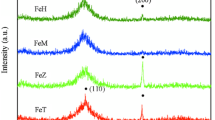Abstract
The oxidation characteristics of the Co-rich amorphous magnetic alloy, \({\text{Co}}_{75.26 - x} {\text{Fe}}_{{\text{4}}{\text{.74}}} \left( {{\text{BSi}}} \right)_{20 + x}\) were investigated. A TEM study of the microstructure revealed a complex oxidation behavior of the alloy depending on composition, especially the boron and silicon concentrations. It was determined that the critical concentration of the metalloid to be 21 at.% above, which a continuous layer of an amorphous borosilicate phase formed on the surface. Phase separation of the surface oxide was also observed when the composition is rich in boron. The metalloid (boron and silicon) concentration was critical in determining the surface-oxide morphology, which in turn, affected the subsurface microstructure. As the magnetization behavior of the Co-rich amorphous alloy depends upon the surface oxide and the internal-oxide precipitates, the guidelines are provided by which one can engineer the microstructure of the alloy to optimize the magnetic properties.
Similar content being viewed by others
REFERENCES
H. Warlimont, in New Magnetic Materials by Rapid Solidification, S. Steeb and H. Warlimont, eds. (Elsevier, New York, 1985), pp. 1599–1609.
K. Mohri, in Amorphous Metal Sensor, A. Hernando, V. Madurga, M. C. Sanchez-Trujillo, and M. Vasquez, eds. (Elsevier, New York, 1987), pp. 360–366.
G. Herzer and H. R. Hilzinger, Amorphous Metal Sensor, pp. 354–359 (1987).
G. E. Fish, Proc. IEEE, 78, 947–972 (1990).
L. Henderson, R. C. O'Handley, and B. L. Averbach, J. Magn. Magn. Mater. 87, 142–146 (1990).
Y. C. Kuo, L. S. Zhang, and W. K. Zhang, J. Appl. Phys. 52, 1889–1891 (1981).
B. Predel, Key Eng. Mater. 40, 17–38 (1990).
U. Koster, Mater. Sci. Eng. 97, 233–239 (1988).
M. Millan, J. Leal, and A. Conde, Mater. Lett. 14, 227–231 (1992).
P. Duhai, P. Svec, M. Durcekova, and G. Vlasak, Mater. Sci. Eng. 97, 337–341 (1988).
U. Koster, B. Punge-Witteler, and G. Steinbrink, Key Eng. Mater. 40, 53–62 (1990).
U. Koster, Proc. '87 Conf. Phase Transformations, pp. 597–603 (1988).
C. K. Kim, Mater. Sci. Eng. B40, 10–18 (1996).
C. Wagner, Z. Elektrochem. 63, 772–782 (1959).
C. Wagner, J. Electrochem. Soc. 99, 369–380 (1952).
Phase Equilibria Diagrams Database Ver. 2.1, NIST standard reference database 31, 1994.
E. M. Levin, Phase Diagram, Vol. 3, The Use of Phase Diagrams in Electronic Materials and Glass Technology (Academic Press, New York, 1970), pp. 144–233.
R. Charles and F. E. Wagstaff, J. Amer. Cer. Soc. 51, 16–20 (1968).
F. A. Hummel, Introduction to Physical Equilibra in Ceramic Systems (Marcel Dekker, New York, 1984), p. 107.
C. K. Kim and R. C. O'Handley, J. Microsc. 180, 70–79 (1995).
Author information
Authors and Affiliations
Rights and permissions
About this article
Cite this article
Kim, C.K., Yoon, C.S., Byun, T.Y. et al. Oxidation of Amorphous Co75.26−xFe4.74(BSi)20+x Magnetic Alloy. Oxidation of Metals 55, 177–187 (2001). https://doi.org/10.1023/A:1010386408279
Issue Date:
DOI: https://doi.org/10.1023/A:1010386408279




